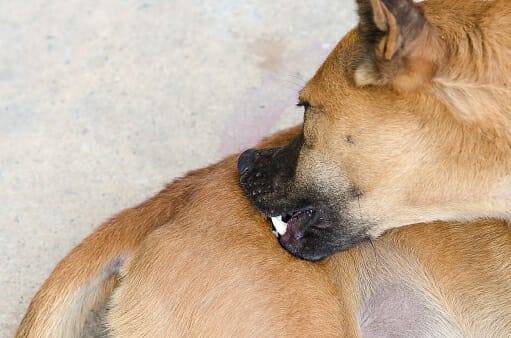Cheyletiellosis (Walking Dandruff) in Dogs and Cats
Cheyletiellosis (walking dandruff) in dogs and cats is caused by mites. Learn the signs and what you can do to help your pet.
Cheyletiellosis is a skin disease that is caused by mites called Cheyletiella spp. (sometimes called ‘walking dandruff’). This mite is contracted from dogs, cats, rabbits, or other animals that are infested with the mite. The mite lives in the superficial layers of the skin and on the surface of the skin. The mite adults, immature forms, and eggs spend most of their time on the skin. They may survive for several days in the environment.
Symptoms of Cheyletiellosis in Dogs and Cats
The pet’s signs may be symptomatic or non-symptomatic (i.e. pets may appear normal, itching very little, but still harbor the mites). Scaling is the most common clinical finding. Another common sign is itching. The scaling and itching are most common over the backs of pets, but can be located anywhere on the body. Due to self-trauma, pets may have secondary crusting in these regions also.
Very few mites are necessary to cause clinical signs.
Diagnosis of Cheyletiellosis in Dogs and Cats
Cheyletiellosis is diagnosed by skin scrapings, flea combings and/or preparations made from scales from the skin. Since the mites are often difficult to find, the diagnosis may also be based on resolution of clinical signs in response to therapy.
These mites can also be contagious to humans about 20% of the time. In humans, the clinical signs are small red, very itchy, grouped bumps often found on the forearms, chest and abdomen. These may have crusted centers. Humans should seek the advice of their physician if they are affected.
Treatment of Cheyletiellosis in Dogs and Cats
There are a variety of treatments available for cheyletiellosis.
- The first, LymDyp, is a sulfur based dip. This dip is very safe and used every 5 to 7 days for six dips. This solution should never be used full strength, it should be diluted as directed on the label. This LymDyp must dry on your pet and it is necessary to treat for the full length of time. The less desirable effects of LymDyp are the rotten egg smell, possible yellow staining and it may tarnish some jewelry.
- The second treatment is ivermectin which is also effective in most cases for the treatment of cheyletiellosis. This is usually given by injection but sometimes is used orally. It is not licensed for use in animals at this dosage but is a widely used treatment for cheyletiellosis. It can not be used in Collies, Shelties, or related breeds. It may cause severe reactions (including coma, personality change, and death) in these breeds. Pets must be heartworm negative prior to initiating therapy.
- A topically applied treatment, Revolution (selamectin) is also effective to treat pets who have this mite, although not labeled for this use. Revolution is applied every two weeks for three treatments.
Home Therapy of Cheyletiellosis in Dogs and Cats
Give all medications as directed. All other animals who contact the patient must also be treated. Household therapy may be needed since the mites may survive for several days off the host. Premise sprays used for environmental flea treatment are usually sufficient to treat the home.
FAQs
Contents


